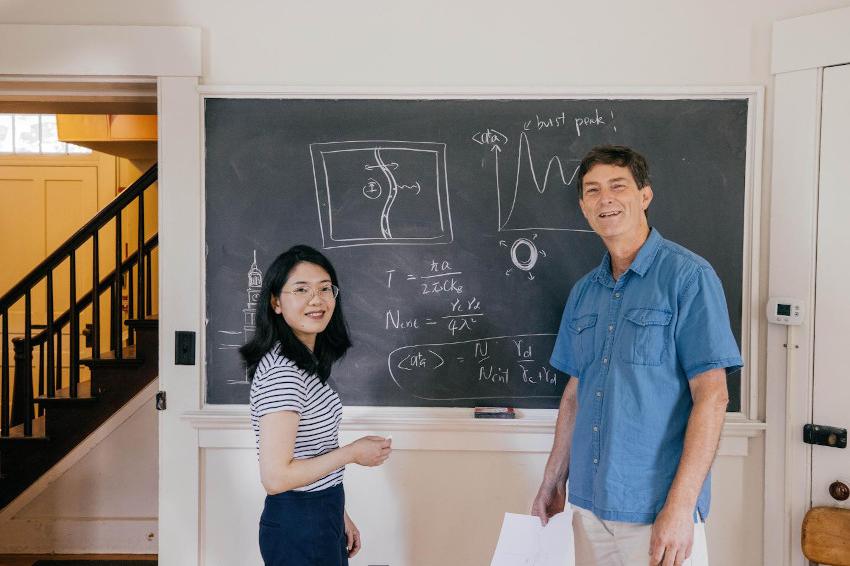Detecting light in the darkness of a vacuum
New experiment could allow researchers to produce and detect light in a vacuum
Black holes are regions of space-time with huge amounts of gravity. Scientists originally thought that nothing could escape the boundaries of these massive objects, including light. The precise nature of black holes has been challenged ever since Albert Einstein’s general theory of relativity gave rise to the possibility of their existence. Among the most famous findings was English physicist Stephen Hawking’s prediction that some particles are actually emitted at the edge of a black hole. Physicists have also explored the workings of vacuums. In the early 1970s, as Hawking was describing how light can escape a black hole’s gravitational pull, Canadian physicist William Unruh proposed that a photodetector accelerated fast enough could see light in a vacuum. New research from Dartmouth advances these theories by detailing a way to produce and detect light that was previously thought to be unobservable.
“In an everyday sense, the findings seem to surprisingly suggest the ability to produce light from the empty vacuum,” said Miles Blencowe, the Eleanor and A. Kelvin Smith Distinguished Professor in Physics at Dartmouth. “We have, in essence produced something from nothing; the thought of that is just very cool.” In classical physics, the vacuum is thought of as the absence of matter, light, and energy. In quantum physics, the vacuum is not so empty, but filled with photons that fluctuate in and out of existence. However, such light is virtually impossible to measure. One part of Einstein’s general theory of relativity, the “equivalence principle,” establishes a connection between Hawking’s prediction for radiating black holes and Unruh’s prediction for accelerating photodetectors seeing light. Equivalence says that gravity and acceleration are fundamentally indistinguishable: A person in a windowless, accelerating elevator would not be able to determine if they are being acted on by gravity, an inertial force, or both.
Therefore, if black hole gravity can create photons in a vacuum, so can acceleration. With science already demonstrating that observation of light in a vacuum is possible, the Dartmouth team set out to find a practicable way to detect the photons. The& research theory predicts that nitrogen-based imperfections in a rapidly accelerating diamond membrane can make the detection. In the proposed experiment, a postage stamp-sized synthetic diamond containing the nitrogen-based light detectors is suspended in a super-cooled metal box that creates a vacuum. The membrane, which acts like a tethered trampoline, is accelerated at massive rates.
The research explains that the resulting photon production from the cavity vacuum is collectively enhanced and measurable, with the vacuum photon production undergoing a phase transition from a normal phase to “an enhanced superradiant-like, inverted lasing phase” when the detector number exceeds a critical value. “The motion of the diamond produces photons,” said Hui Wang, a postdoctoral researcher at Dartmouth. “In essence, all you need to do is shake something violently enough to produce entangled photons.” The theory investigates using multiple photon detectors to amplify the acceleration of the membrane and increase detection sensitivity. Oscillating the diamond also allows the experiment to take place in a controllable space at intense rates of acceleration.
“Our work is the first to explore what happens when there are many accelerating photodetectors instead of one,” said Blencowe. “We discovered a quantum-enhanced amplification effect for light creation from vacuum, where the collective effect of the many accelerating detectors is greater than considering them individually.” To confirm that the detected photons come from the vacuum rather than from the surrounding environment, the team demonstrates that the theory observes entangled light, a distinct feature of quantum mechanics that cannot originate from outside radiation. “The photons detected by the diamond are produced in pairs,” said Hui. “This production of paired, entangled photons is evidence that the photons are produced in vacuum and not from another source.”
The proposal to observe light in a vacuum does not have immediate applicability, but the research team hopes that it adds to the understanding of physical forces that contributes to society in the way other theoretical research has. In particular, the work may help shed experimental light on Hawking’s prediction for radiating black holes through the lens of Einstein’s equivalence principle. “Part of the responsibility and joy of being theorists such as ourselves is to put ideas out there,” said Blencowe. “We are trying to show that it is feasible to do this experiment, to test something that has been until now extraordinarily difficult.” (Source: Dartmouth Col.)
Link: Dept. of Physics and Astronomy, Dartmouth College, Hanover, USA






